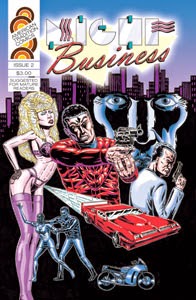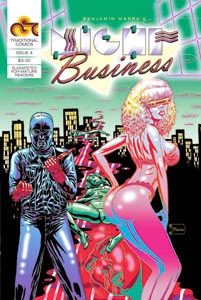Wednesday, June 26, 2013
INTERVIEW | AQNB
I'm interviewed over at the art-and-design, culture site AQNB (Atractivo Que No Bello, I believe). Check it out here.
Wednesday, June 19, 2013
SIDE PROJECT: XOXO
Robin McConnell's XOXO anthology, comprised of stories inspired by the TV show Gossip Girl by various comic book artists, is up over at the Study Group website. Included is a story I did. I'm a big fan of Gossip Girl so this was a lot of fun to do.
Monday, June 17, 2013
SIDE PROJECT: GALACTIC BREAKDOWN PIN-UP
Above is my pin-up set to appear in the upcoming issue of GALACTIC BREAKDOWN A.K.A. SPACE BATTLEGROUND 666 by Keenan Marshall Keller for his Drippy Bone Books publishing house. Below are my sketch and a couple of in-process images.
THE MARRA METHOD: TRADITIONAL COMICS TECHNIQUES FOR VISUAL STORYTELLING | 5. Do Not Decompress
An on-going, evolving series collecting my thoughts on the craft of telling stories through comic books. These posts do not document rules; these are the ideas passing through my mind when I'm making comic books.
• Do not decompress. But also, do not compress these narrative elements too much either. Find the balance. Find what is necessary.
• It became common in mainstream comics to decompress stories for the financial benefit of the writers and artists working on the books, but in the long run it hurts the medium and the legacies of those creators.
• It makes economic sense for the writer (or artist), who gets paid by the page, to stretch a story that could be told in three issues to six issues. But the practice is to the detriment of the readers' experience. The other adverse effect is to the amateur comic book creator who is being influenced by the mainstream comic book professional.
• Another reason for mainstream decompression was the rise in trade paperback collection sales. Stories were padded or extended to six issues—when fewer would suffice—to fit the trade paperback format.
• These techniques are an affront to the Story.
• You do what the Story requires, you answer to the Story and nothing else.
• Strunk believed the key to successful writing is efficient writing: Cut needless words. It is the same with comic books. You cut needless panels, needless pages, don't draw needless lines and cut needless words, too. You use exactly the amount that is required to tell the Story.
5. Do Not Decompress
• Just like in prose where a scene, a description, an action, simply require the necessary amount of words to be communicated, a scene, a description, an action, in comic books require the precise amount of panels they need to be communicated. No more, no less.• Do not decompress. But also, do not compress these narrative elements too much either. Find the balance. Find what is necessary.
• It became common in mainstream comics to decompress stories for the financial benefit of the writers and artists working on the books, but in the long run it hurts the medium and the legacies of those creators.
• It makes economic sense for the writer (or artist), who gets paid by the page, to stretch a story that could be told in three issues to six issues. But the practice is to the detriment of the readers' experience. The other adverse effect is to the amateur comic book creator who is being influenced by the mainstream comic book professional.
• Another reason for mainstream decompression was the rise in trade paperback collection sales. Stories were padded or extended to six issues—when fewer would suffice—to fit the trade paperback format.
• These techniques are an affront to the Story.
• You do what the Story requires, you answer to the Story and nothing else.
• Strunk believed the key to successful writing is efficient writing: Cut needless words. It is the same with comic books. You cut needless panels, needless pages, don't draw needless lines and cut needless words, too. You use exactly the amount that is required to tell the Story.
Labels:
THE MARRA METHOD
Tuesday, June 11, 2013
COMICS ALLIANCE REVIEW
Over at the recently resurrected Comics Alliance website, Chris Sims reviews his haul from the weekend at Heroes Con, including the TRADITIONAL COMICS comics he picked up. Check it out here.
HEROES CON COMMISSIONS
My buddy Shannon commissioned two pieces from me over the last weekend at Heroes Con in Charlotte. I ended up doing two Kirby-related characters: Orion and Thundarr. Orion is probably my favorite superhero design ever. Thundarr is the best Saturday Morning Cartoon ever.
Tuesday, June 4, 2013
HEROES CON 2013
I'll be at the great Heroes Con this weekend, June 7th through the 9th, in Charlotte, NC. Heroes Con is an amazing convention. If you're in the area swing by. I'll be at table AA-1115 (see the above map). I'll have the usual TRADITIONAL COMICS books. Matthew D. Smith will be next to me at table AA-1116.
THE MARRA METHOD: TRADITIONAL COMICS TECHNIQUES FOR VISUAL STORYTELLING | 4. WRITE AN OUTLINE. THEN DRAW THE PICTURES AND WRITE THE WORDS NEXT.
An on-going, evolving series collecting my thoughts on the craft of telling stories through comic books. These posts do not document rules; these are the ideas passing through my mind when I'm making comic books.
• You may use two short sentences for one comic book page in outlines, but the "one sentence = one comic book page" is a good formula.
• Make a list of page numbers on the left side and then write the sentence of what occurs on each page.
• Sketch out the page layouts in 6" x 9" boxes (approximately printed size), telling the story with the pictures first.
• Convey, using pictures, the narrative information that is to take place on each page based on the sentences written in the outline.
• Then use the pictures in the layouts to inspire the words, writing them in the space you've provided: caption descriptions, speech balloons, thought balloons and sound effects.
• Comics should not be made from a prose script. In addition to delivering narrative information, the words on the page are a design element and the space they occupy MUST be accounted for as they are written. In employing prose script—like a play or screenplay—the comic writer cannot visualize the necessary space the words occupy on the page.
• A prose script gives undue superiority to the words in comics, when they must work in unison for the benefit of the Story. Comic book writers must draw the layouts of the pages.
• I do not see how any comic books could be successful any other way.
- (Side thought: Did Alan Moore provide Dave Gibbons with layouts for Watchmen? I know he did for Bart Sears in the Violator limited series).
• The Marvel Method is my evidence against prose scripts and for drawing pictures first, then entering words, in creating comic books. The Kirby/Lee collaboration, particularly on their Fantastic Four run, are perfect comic books.
4. Write an Outline. Then Draw the Pictures and Write the Words Next.
• If memory serves, Joe Casey got his outline method from Stephen Grant, who said, everything that takes place on the page of a comic can be told in one sentence.• You may use two short sentences for one comic book page in outlines, but the "one sentence = one comic book page" is a good formula.
• Make a list of page numbers on the left side and then write the sentence of what occurs on each page.
• Sketch out the page layouts in 6" x 9" boxes (approximately printed size), telling the story with the pictures first.
• Convey, using pictures, the narrative information that is to take place on each page based on the sentences written in the outline.
• Then use the pictures in the layouts to inspire the words, writing them in the space you've provided: caption descriptions, speech balloons, thought balloons and sound effects.
• Comics should not be made from a prose script. In addition to delivering narrative information, the words on the page are a design element and the space they occupy MUST be accounted for as they are written. In employing prose script—like a play or screenplay—the comic writer cannot visualize the necessary space the words occupy on the page.
• A prose script gives undue superiority to the words in comics, when they must work in unison for the benefit of the Story. Comic book writers must draw the layouts of the pages.
• I do not see how any comic books could be successful any other way.
- (Side thought: Did Alan Moore provide Dave Gibbons with layouts for Watchmen? I know he did for Bart Sears in the Violator limited series).
• The Marvel Method is my evidence against prose scripts and for drawing pictures first, then entering words, in creating comic books. The Kirby/Lee collaboration, particularly on their Fantastic Four run, are perfect comic books.
Labels:
THE MARRA METHOD
Subscribe to:
Posts (Atom)
















